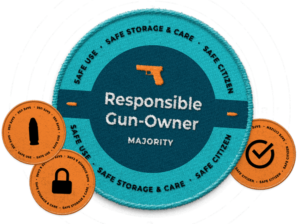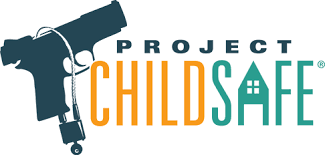Gun Safety
Protect What Protects You.
You own and carry firearms to protect your family and community. But firearms stolen from gun owners are being used to commit the crimes you want to prevent.
One common threat many people overlook: firearms theft. 400,000 firearms are stolen from individual owners every year. Theft is one of the top sources of firearms used in crimes. Protect your firearms and spread the word.

GENERAL GUN SAFETY RULES WHEN HANDLING A FIREARM
 Treat all firearms as loaded until you have checked the gun, no matter what !!
Treat all firearms as loaded until you have checked the gun, no matter what !!
Always point the muzzle in a safe direction. Whether you are shooting or simply handling your gun, never point the muzzle at yourself or others. Common sense should dictate which direction is the safest depending on your location and other conditions. When on the range, always point your firearm down range.
Be sure of your target and what is around and beyond it. Be positive you have identified your target beyond all doubt. Equally important, be aware of the area behind your target. This means observe your area of fire before you shoot. Never fire in a direction in which there are people or any other potential for mishap.THINK FIRST – SHOOT SECOND !
Keep your finger off the trigger until you are ready to shoot. There is a natural tendency to place your finger on the trigger when holding a gun. Avoid it !!! That is what trigger guards are made for – to enable you to hold the gun comfortably with your finger off the trigger.
Keep the action open and gun unloaded until you are ready to shoot. Whenever you pick up any gun, immediately open the action and check (visually if possible) to see that the chamber is unloaded. If the gun has a magazine, remove it and make sure it is empty. If you do not know how to open the gun’s action, leave it alone and get help from someone who does.
CLEANING
Before cleaning your firearm, make absolutely sure that it is unloaded. All ammunition should be stored away from the cleaning area. The gun action should be open during the cleaning process. Regular cleaning is important. Your gun should be cleaned after each use. A gun brought out of prolonged storage should be cleaned before shooting. Accumulated moisture, dirt or grease can interfere with the gun’s safe operation. The cleaning of firearms on club property is permitted in designated areas only.

STORAGE
Several factors should be considered when you decide on where and how you intend to store your firearms. Your particular needs will be a major part of the consideration. Safe and secure storage requires that all untrained individuals (especially children) be denied access to your guns.
A Protect What Protects You Partnership.
The National African American Gun Association is a pro-Second Amendment organization of responsibly armed citizens, offering education, training and support to gun owners through more than 70 chapters nationwide. They have made Protect What Protects You a part of their education and training programs.
Safety with firearms, as with any other potentially hazardous machines, comes through learning and practicing safe procedures until they become a habit. With proper knowledge, skill, and a respect for firearms, accidents will not occur. Firearms are dangerous only when people make them so. When handled improperly they can become instruments of danger to people and property; when handled correctly there is no danger. Obedience to the rules of safety and range commands makes target shooting a safe sport.
Accidents don’t just happen. They are caused by ignorance or disregard for safety rules. The rules of safety and proper handling of firearms should be practiced until they are never out of mind. They should be observed at all times. Always remember, safety first, safety last and safety always.
WHEN SHOOTING A GUN:
Know how the gun operates. Before handling any firearm, learn how it operates. Know the basic parts, how to open and close the action safely and how to safely remove ammunition from the gun or magazine. Always remember, a gun’s safety device is never foolproof. Nothing can replace safe gun handling.
Be sure your gun and ammunition are compatible. Only BBs, pellets, cartridges or shells designed for a particular gun can be fired safely in that gun. Most guns have the ammunition type stamped on the barrel. Ammunition can be identified by information printed on the box and sometimes stamped on each cartridge. Do not shoot the gun if there is any question about the compatibility of the gun and ammunition.
Carry only one gauge/caliber of ammunition when shooting. Smaller ammunition can be accidentally placed in a gun chamber designed for larger ammunition creating an obstruction and a hazard. Remove unfired ammunition from clothing when you are finished shooting in order to avoid accidentally mixing different ammunition the next time you shoot.
Wear eye and ear protection as appropriate. Guns are loud. They can also emit debris and hot gas that could cause eye injury. Safety glasses and ear protection are MANDATORY. A bit of precaution may save your sight and hearing.
Do not mix alcohol or drugs with shooting. Alcohol and drugs are likely to impair normal mental and physical bodily functions and must not be used before or while handling or shooting guns.
Be aware that circumstances may require additional rules unique to a particular situation. The basic rules as listed above for safe handling and shooting of firearms may need to be supplemented with other rules. An example would be that different types of ranges, such as pistol or trap, may have specific rules that must be learned and followed. Remember, whether in the home, at the range, or in the field, you are the person that is responsible for gun safety.
